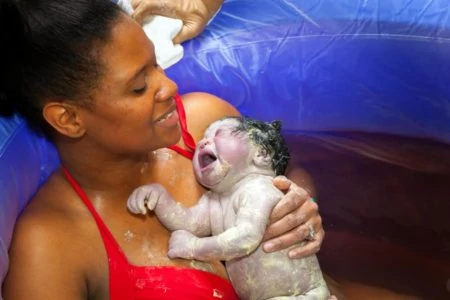Are you pregnant and expecting a bouncing baby boy? Maybe you’ve recently had a son. Choosing circumcision is a much-debated topic, but is it good or bad?
People will sit in different camps. For some, it’s a religious or cultural necessity, and for others, it’s a matter of choice. So how do you decide what is best for your child?
We will give you a complete overview of the reasons why circumcision takes place, and what the benefits and risks of circumcision are.
What Is Circumcision?
Circumcision is a surgical procedure that removes the piece of the skin that covers the tip of the penis. It’s a common procedure in many countries, including the U.S. It’s performed on a baby boy, often when he’s a newborn, usually before he is 10 days old.
The procedure takes about 10 minutes and a local anesthetic is applied. A plastic ring is put on the penis and what we call the foreskin is removed. The procedure is similar for older boys and men but is usually carried out under general anesthesia.
Circumcision Statistics
Circumcision is common in many countries. Before we look at reasons for male circumcision, let’s see what the statistics are in the U.S. and elsewhere in the world. Globally, it’s thought that an estimated 37 percent of males are circumcised (1).
- United States: In the United States, about 70 percent of males have undergone this procedure. This varies between the different U.S. regions. The highest prevalence of circumcision at birth is in the Midwest at about 70 percent, and Northeast just under that. Lower figures are reported elsewhere, down to just over 55 percent in the South and 35 percent in the West. The trend for circumcision rose during the 90s and then started dropping at the turn of the millennium. It has risen again slightly in recent years (2).
- Canada: The rate for circumcision in Canada is much lower, at about 31 percent. Again this varies in different parts of the country. Labrador and Newfoundland have close to zero and Alberta is at 44 percent (3).
- Asia: Most of Asia also has low circumcision rates, with the exception of those who circumcise for religious reasons. These include Israel, the Philippines, Malaysia, the United Arab Emirates, and Saudi Arabia, to name a few. The prevalence in these particular countries is high, at more than 90 percent.
- Africa: Africa has a high prevalence in some areas. In the North for religious reasons, and Central Africa for cultural reasons as part of tribal rituals, the figures are over 90 percent. The overall percentage for the continent is about 62 percent.
- Europe: Europe has on average less than 20 percent of males circumcised.
- Australia and New Zealand: Circumcision was quite popular in Australia in the 1950s, reaching about 80 percent. However, in recent years it has dropped to around 26 percent (4). New Zealand, like Europe, has less than 20 percent of males circumcised.
Why People Circumcise Their Sons
These are the most common reasons are for people having their babies circumcised.
- Religion: Followers of Islam and Judaism perform circumcision on their male children.
- Culture: Some African and Aboriginal groups, as well as Aztecs, Mayans, and some other cultures, circumcise boys as part of tribal rituals. It is done to denote a passage into manhood (5).
- The desire to conform: Some get their infants circumcised so they don’t appear different from their father. Others, where circumcision is done as a teen, do it so they don’t look different from their peers.
- Aesthetic preference: Some might think the penis looks better without the foreskin and circumcise for this reason.
There are also health reasons why parents might choose to circumcise their son or why it has to be done later in life. These include:
- Hygiene: A circumcised penis is easier to clean than one that is intact.
- Less risk of urinary tract infection: Although this is not a common complaint in males, it is lower in those that are circumcised.
- Decreased risk of sexually transmitted diseases: Infection from diseases of this nature, including HIV, is lowered. It does not prevent them, however, and safe sex should still be practiced.
- Less risk of penile cancer: The risk of cancer of this nature is lower when the penis is circumcised.
The following health conditions can happen in both children and adults:
- Balanitis: This infection of the glans area of the penis can cause swelling of the foreskin and require circumcision (6).
- Balanoposthitis: This condition only occurs in intact males. It presents as a red, swollen painful glans and foreskin with a foul discharge. It can cause scar tissue and tighten the foreskin (7).
- Phimosis: This condition means the foreskin cannot be retracted over the glans (8).
- Paraphimosis: This happens when a retracted foreskin cannot be moved back over the glans. It can cause a restrictive band around the penis and needs to be dealt with as a medical emergency. One of the treatments for this is circumcision (9).
Pros of Circumcision
There are benefits to health that can be gained from circumcision.
1. Reduced Risk of Urinary Tract Infection
Intact boys under one-year-old are between 10 and 20 times more likely to get a urinary tract infection. It is one of the most common reasons discussed when parents decide whether to get their son circumcised (10).
These infections are caused by bacteria that collect and colonize near the entrance to the urethra. These organisms, like E. coli and Klebsiella, are more likely to be found in higher concentrations when a foreskin is present. This is especially the case in infants under six months old (11).
While the risk is low, these types of infection, particularly when they are recurrent, can lead to kidney problems later in life (12).
Circumcision does not eliminate the risk of urinary tract infections but significantly lowers it.
The overall risk of urinary tract infection in men is still low. For example, for infants 0 to 1 years old, the risk of an intact male getting a UTI is 1.3%, while a circumcised male is only 0.3%. That difference is very small between the two. (13)
Editor's Note:
Caitlin Goodwin, MSN, RN, CNM2. Reduced Risk of Penile Cancer
It’s worth noting this type of cancer is rare. Studies estimate that about 2,320 men were diagnosed with penile cancer in the U.S. in 2018 (14).
There are several risk factors for this cancer, which include HPV infection, smoking, age, HIV, and some psoriasis treatments. The other two risk factors that come into play in respect of circumcision are smegma and phimosis (15).
Smegma is a build-up of skin cells, oily skin secretions, and bacteria under the foreskin. It’s a thick substance which, if not cleaned properly, can irritate the penis. It also contains some small amounts of substances which can cause cancer.
Phimosis, as we have mentioned, means you can’t retract the foreskin easily. In turn, you then won’t be able to clean the penis properly and smegma can build up.
While circumcision cannot completely prevent penile cancer, it lowers your risk. It makes it easier to keep the penis clean, as smegma cannot be trapped and build up (16).
3. Reduced Risk of STDs and HIV
Circumcision can reduce the risk of some sexually transmitted diseases. One of these is the human papillomavirus or HPV. This virus can cause genital warts and cancer (17).
There are also indications male circumcision can help prevent HPV from causing cervical cancer in women (18).
There is less likelihood of a circumcised male contracting gonorrhea or syphilis (19).
In the case of HIV, reports from the World Health Organization indicate circumcision can reduce the risk by up to 60 percent (20).
On the inside of the foreskin, Langerhans cells, which prevent threats from entering our body through the skin, are close to the surface. It is thought that viruses, like HIV, can enter our system by attaching to these cells. When the foreskin is removed, the skin on the glans is thicker and does not allow passage of the virus as easily.
4. Easier to Keep Genital Area Clean
Cleaning a penis which has been circumcised simply means washing it daily in warm water. When a foreskin enters the equation, it’s a little more involved.
The foreskin needs to be gently retracted to ensure it is cleaned underneath. If this isn’t done, then smegma can build up and bacteria can breed. The result could be the redness and swelling we have mentioned, called balanitis (21).
In infants, the foreskin cannot and should not retract and you should simply clean it with soap and water. Don’t be tempted to try to clean underneath with cotton swabs. You can cause significant issues by retracting it too early. More than 90% of children can retract their foreskins by age 5 years old, but you should never force it. The foreskin should retract by puberty.
As your child gets older, the foreskin becomes detached from the glans and can be retracted gently. You will need to teach your little one how to clean it properly (22).
5. Prevention of Certain Medical Conditions
The medical conditions we highlighted earlier — balanoposthitis, phimosis, and paraphimosis — can be eliminated through circumcision.
In the case of balanitis, the chances of contracting it are far less once a boy has been circumcised (23).
Cons of Circumcision
Circumcision is not all clear sailing. As well as the pros, there are also some cons to circumcision. To give you a full picture, let’s detail some of them.
1. Changes to the Natural Appearance of the Genitals
There are many controversies associated with infantile circumcision. One of these is the school of thought that the foreskin is there for a purpose. It is part of the male anatomy when they are born, formed as nature intended.
Cutting this off is viewed by some as deforming the natural appearance of the genitals (24).
2. Is Circumcision Unethical?
This is another controversial topic with respect to circumcision. Many see circumcision of an infant as unethical and a violation of their right to choose. The decision is made for them, whether this is for religious or cultural reasons or just the wishes of their parents.
Some feel that unless it is medically necessary, then circumcision should be left until a boy is old enough to make his own informed decision.
There are even some people who believe it goes against the ethics of doctors to perform this procedure. They see it as unnecessary and believe that doctors should protect a child from such a procedure (25).
3. Circumcision Can Be Painful
Let’s be honest, as a new mom, the last thing you want to do is put your little one through a painful surgical procedure. When you weigh the pros and cons, this is a factor to take into account.
One study in Canada was set up to find out which anesthesia was best for performing circumcision. To do this, they needed a control group that had no anesthesia. The doctors and surgical assistants recognized which babies were anesthetized and which weren’t, due to their reactions to the procedure.
While the study recommends the use of anesthesia, the trial was stopped sooner than planned, due to the obvious difference in the babies’ reactions.
4. Risks Associated With Procedure
While circumcision is a straightforward procedure and is regularly completed by many doctors, it is not without risks.
About 35 percent of babies can hemorrhage after the operation. This bleeding is associated more with babies who are circumcised at three months or older. It seems the best time for circumcision to avoid excess bleeding is during the first four weeks of life (26).
Wound infection can also affect about 10 percent of baby boys after this surgery. The risk of infection is likely to be higher when circumcision is performed by untrained people, including unqualified nurses, physicians, or religious leaders.
Infections include streptococcal and staphylococcal infections, abscesses, and cellulitis. For this reason, the procedure should be carried out by a trained professional under sterile conditions.
Meatitis is inflammation in the urinary tract and can manifest in about eight to 20 percent of circumcisions. It is caused by exposure to ammonia in urine-saturated diapers (27).
5. Health Benefits Are Not Immediate
Of the many health benefits that circumcision offers, few of these will apply while your child is still small.
One of the immediate advantages is the ease of keeping the penis clean. The other, the slight reduction in risk for urinary tract infections. The other medical conditions are not present in babies and therefore don’t make any difference at this stage of their lives.
FAQs
Is Circumcision Necessary?
Circumcision is a choice that you as parents will make on behalf of your child. The American Academy of Pediatrics (AAP) advocates that there are many health benefits to performing circumcision on newborns. Nevertheless, although the benefits outweigh the risks, they don’t recommend it as a matter of course for all boys.
When performed under proper sterile conditions with the right anesthetic, it’s a well-tolerated procedure. Circumcision on a newborn has fewer complications than when it is done later in a child’s or man’s life. When there are any complications, they are generally minor.
Circumcision is not mandatory for all newborn males. The decision rests with the parents who make an informed choice on their child’s behalf (28).
Your doctor can advise you of the benefits and risks that apply to your child. You are entitled to make a choice taking into account your own religious, ethical, and cultural beliefs.










